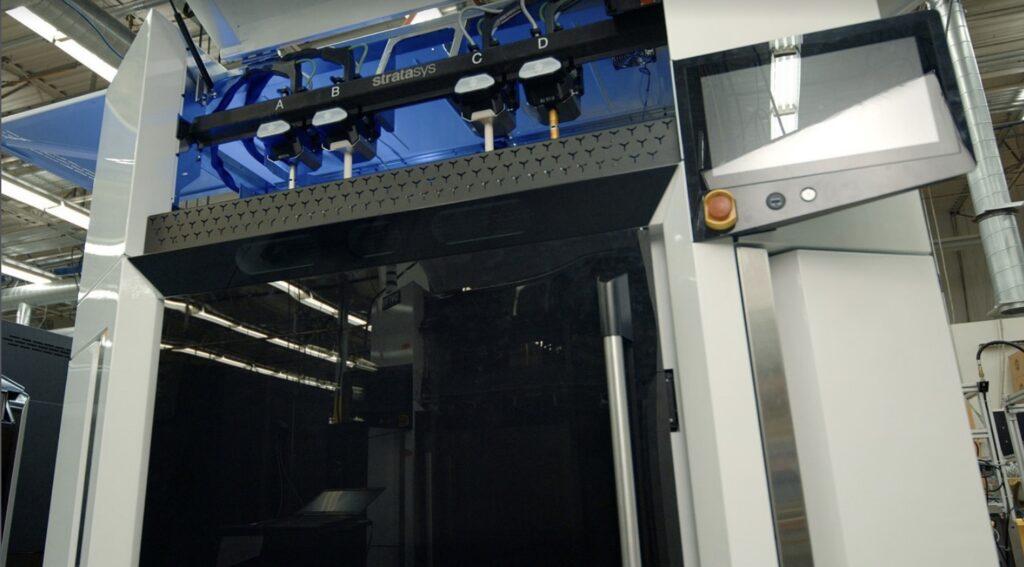Stratasys (Nasdaq: SSYS) has unveiled its latest material extrusion 3D printer, the F3300, just in time for Formnext, targeting the aerospace, defense, and service bureau markets. The first customer for the new system is Japanese automotive giant Toyota.
Set to hit the market in 2024, the F3300 not only operates with greater speed and agility but also surpasses its predecessors by 25% in print speed. Stratasys also asserts that this system will cut costs dramatically, by approximately 25-45%. Featuring a build volume of 600 mm x 600 mm x 800 mm, the printer includes a tool changer and utilizes a unique filament diameter, distinguishing it from other Stratasys systems.
“Rising global supply chain challenges, conventional capacity limitations, and application complexity are placing incredible stress on manufacturing. The F3300 will empower customers to accelerate product development, allowing them to innovate faster, overcome production challenges, be quicker to market, and maximize their return on investment,” said Rich Garrity, Chief Industrial Business Unit Officer for Stratasys. “This next-generation additive manufacturing system empowers customers to scale production and reduce the need to compromise between additive and traditional manufacturing solutions. Rising global supply chain challenges, conventional capacity limitations, and application complexity are placing incredible stress on manufacturing. The F3300 will empower customers to accelerate product development, allowing them to innovate faster, overcome production challenges, be quicker to market, and maximize their return on investment.”
 Stratasys is generating buzz with the promise that the F3300 will deliver cost savings of 25-45% compared to other systems, heralding the potential for more viable business models and applications. Slated to join the lineup that features the top-tier F900, the F3300 is marketed as a production system offering a lower cost per part and designed for high connectivity with enhanced data output capabilities for increased part production. In contrast, the F900 maintains its role as a more independent system, compatible with existing Stratasys equipment through shared filament diameters, build sheets, and other features.
Stratasys is generating buzz with the promise that the F3300 will deliver cost savings of 25-45% compared to other systems, heralding the potential for more viable business models and applications. Slated to join the lineup that features the top-tier F900, the F3300 is marketed as a production system offering a lower cost per part and designed for high connectivity with enhanced data output capabilities for increased part production. In contrast, the F900 maintains its role as a more independent system, compatible with existing Stratasys equipment through shared filament diameters, build sheets, and other features.
The F3300 distinguishes itself with differently sized build sheets, spools, and a unique filament diameter. A noteworthy upgrade includes completely redesigned extruders that deposit more material efficiently. The inclusion of a tool changer facilitates swift transitions between materials without the need for cooling and reheating nozzles, enhancing the capability to switch colors rapidly. Equipped with four material bays and filament pre-drying, the system is optimized for speed with a travel speed significantly faster than previous models. This model features an extruder that moves vertically, streamlining the transition to new layers, complemented by advanced automatic calibration features.
“Having the opportunity to incorporate the F3300 3D printer into our Additive operations represents a great leap forward towards achieving our corporate goals,” said Eduardo Guzman, Advanced Technologies Manager at Toyota. “The new printer capabilities will help us accelerate the introduction of new additive manufacturing opportunities across our manufacturing operations”
Initially, the F3300 will be compatible with materials such as ASA, polycarbonate, polyamide 12 CF, and ULTEM 9085, the latter being particularly favored in aerospace applications for parts ranging from drone wing segments to general aviation interior assemblies. ASA is commended for its durability, particularly for outdoor applications, often yielding better results than the similar ABS. The PA 12 CF stands out as a robust manufacturing material, already in extensive use for end-use parts by machine builders.
While the company plans to introduce soluble and breakaway supports, the system will not support open materials, a point of contention for those who advocate for more flexibility and cost reduction in manufacturing. Despite this limitation, the new system has sparked enthusiasm, especially given Stratasys’s recent focus on rebranding and tailoring software across its range to suit specific market segments, like dental, rather than on introducing new material extrusion technology.
With its shift towards a multiple nozzle setup and moving nozzles rather than the plate, Stratasys has reignited interest in its technological advancements. There is an eagerness to explore how this system will perform in high-volume production and its potential to transform manufacturing efficiencies.
Subscribe to Our Email Newsletter
Stay up-to-date on all the latest news from the 3D printing industry and receive information and offers from third party vendors.
Print Services
Upload your 3D Models and get them printed quickly and efficiently.
You May Also Like
Nikon SLM Solutions Sells SLM 500 to Primary Weapon Systems to Expand Suppressor Production
Primary Weapons Systems (PWS) is a Boise, Idaho-based manufacturer of suppressors, firearms, and related components. A subsidiary of Vigilant Gear and a sister company to aftermarket Glock slide manufacturer Lone...
3DPOD 261: Tooling and Cooling for AM with Jason Murphy, NXC MFG
Jason Murphy´s NXC MFG (Next Chapter Manufacturing) is not a generalist service; instead, the company specializes in making tooling. Using LPBF and binder jet, the company produces some of the...
HP and Firestorm Labs Form Partnership to Use Multi Jet Fusion 3D Printers in Deployable Factories
HP Inc., maker of a range of additive manufacturing (AM) solutions including the Multi Jet Fusion (MJF) ecosystem, has announced a partnership with Firestorm Labs, a developer of containerized, deployable...
3D Printing News Briefs, July 2, 2025: Copper Alloys, Defense Manufacturing, & More
We’re starting off with metals in today’s 3D Printing News Briefs, as Farsoon has unveiled a large-scale AM solution for copper alloys, and Meltio used its wire-laser metal solution to...

































